Lexicography Lexicography is a discipline that involves




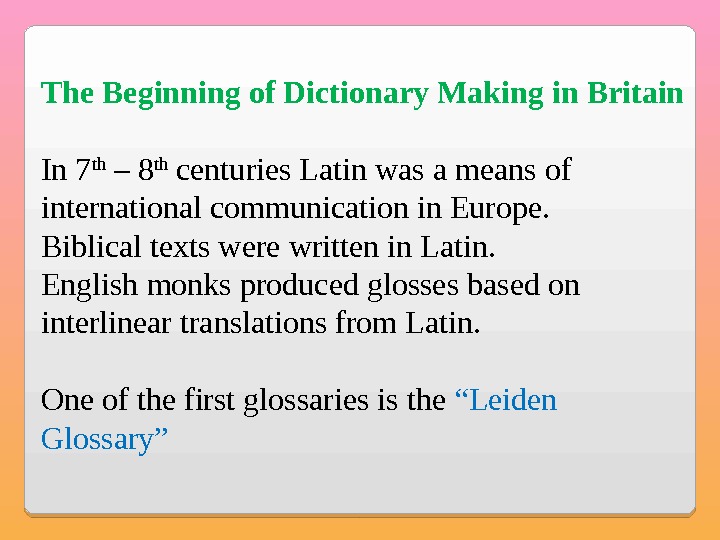
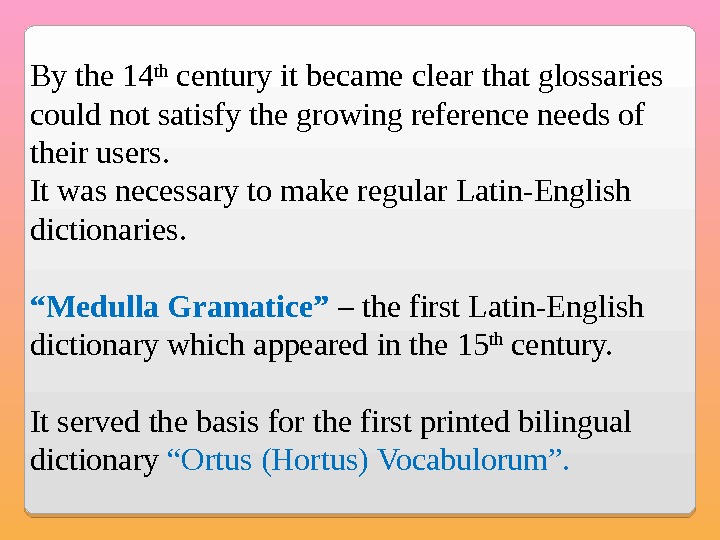
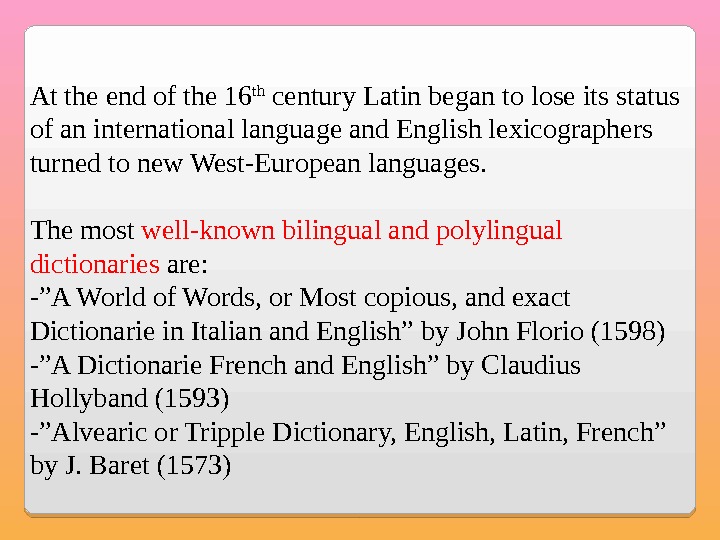

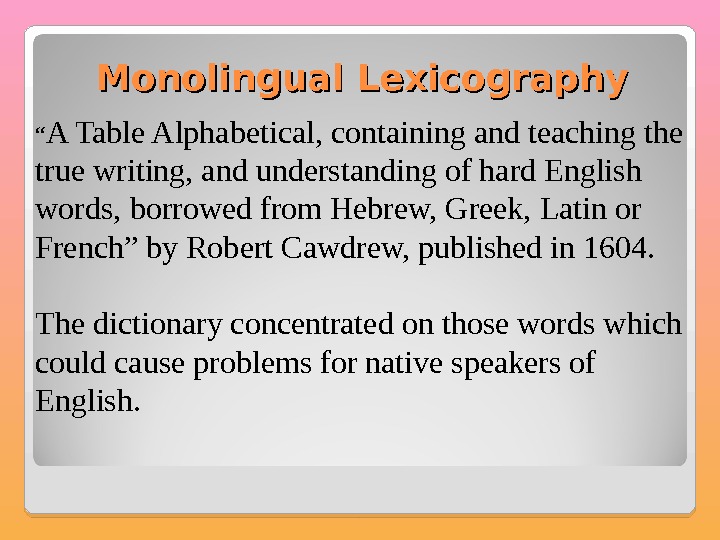

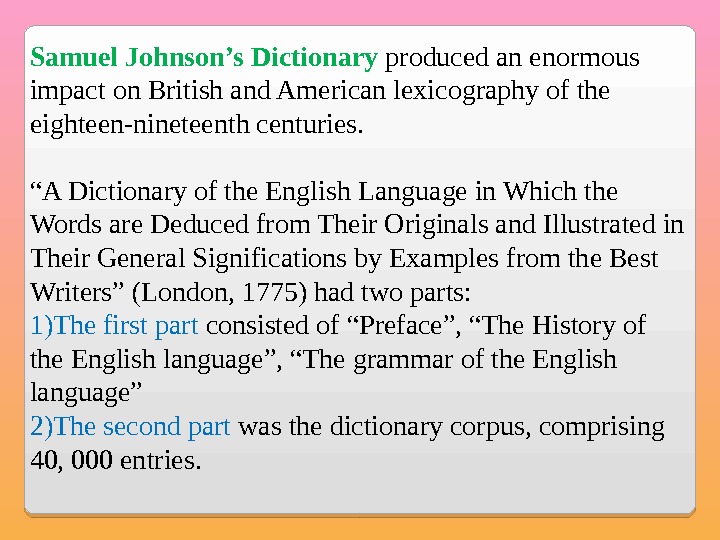
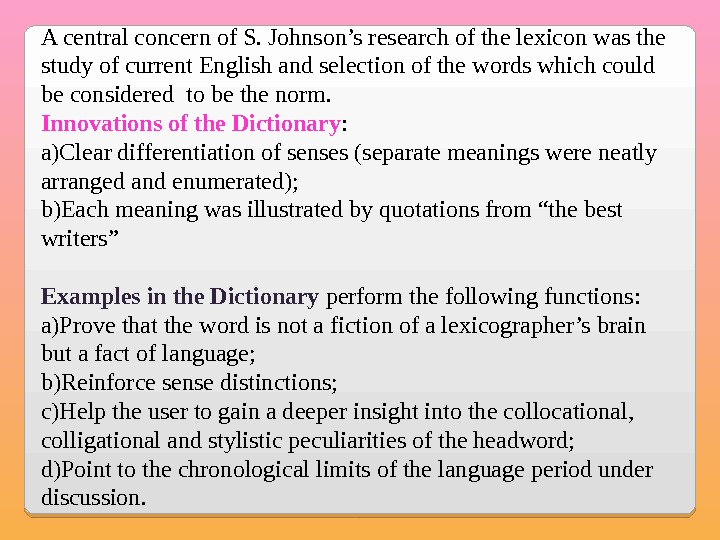

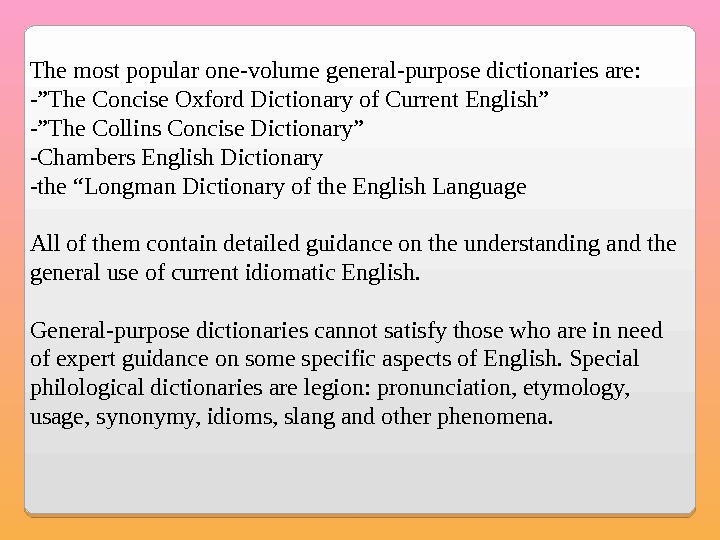




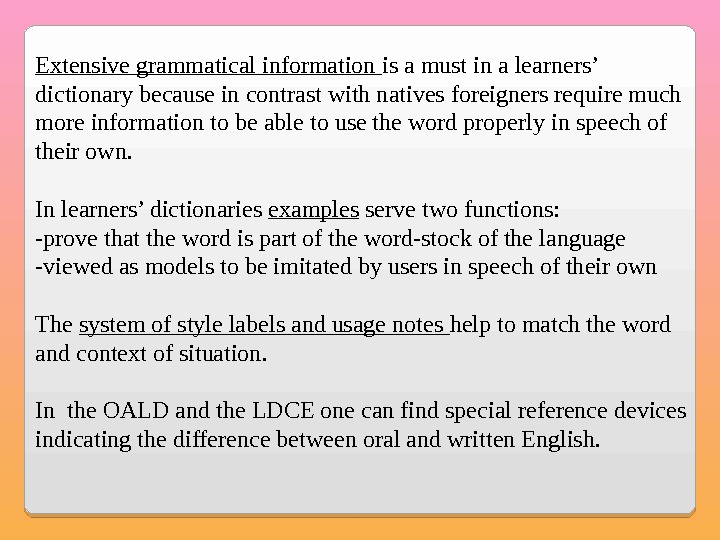
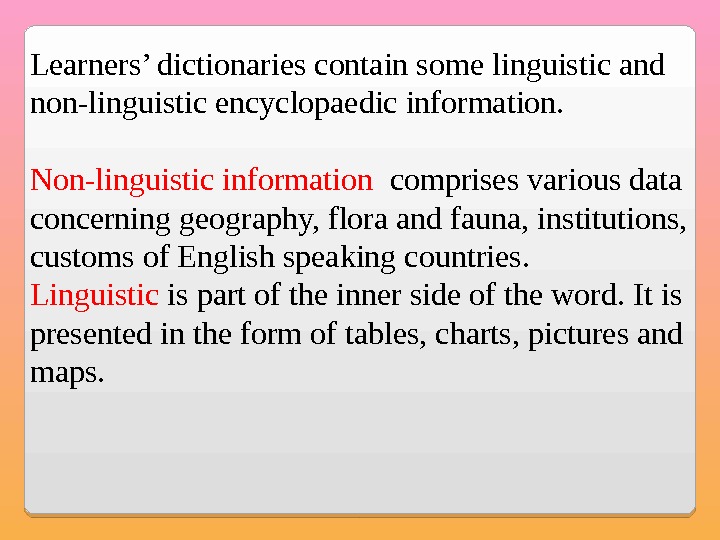


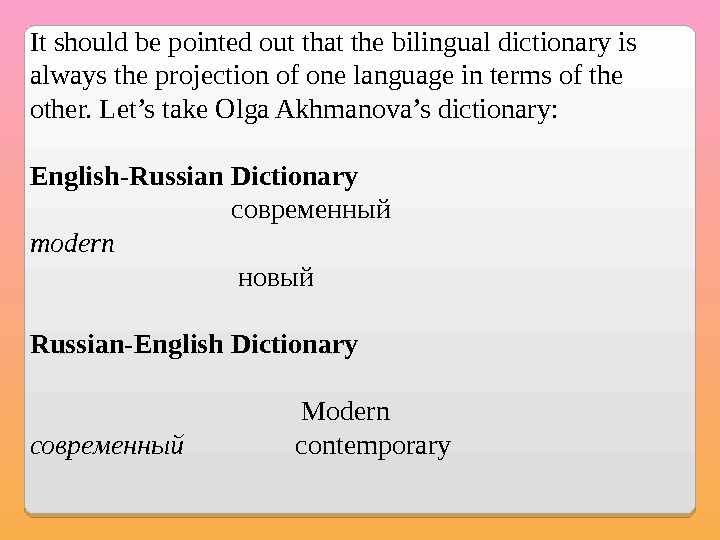


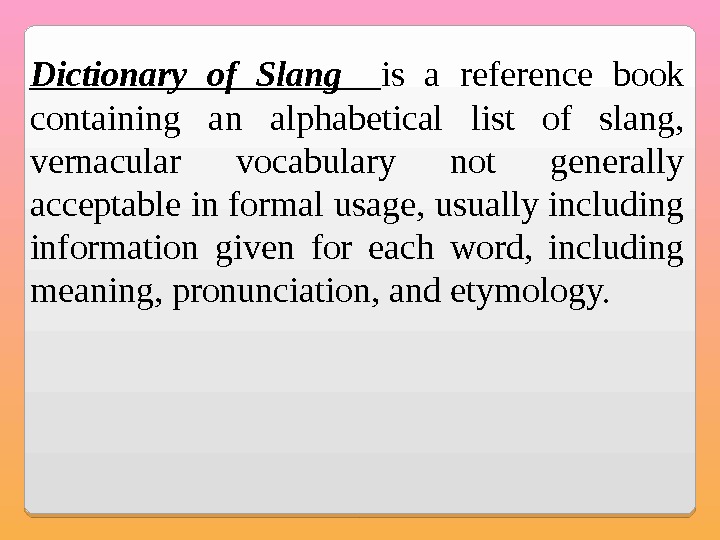

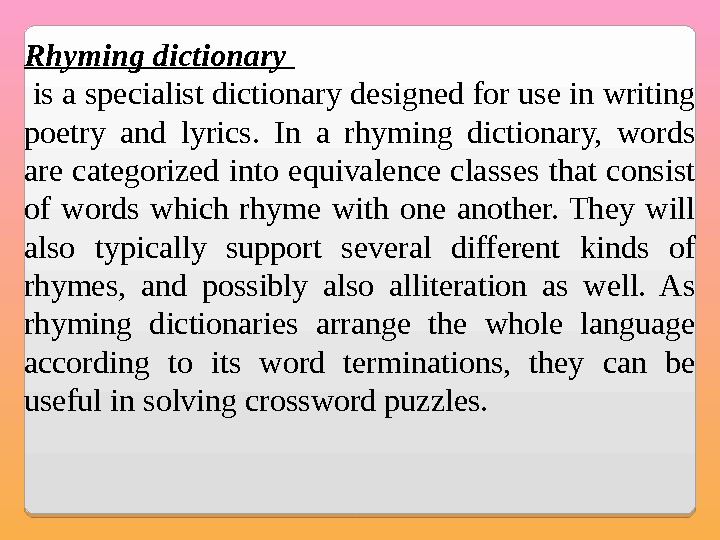

lecture_on_lexicography.ppt
- Размер: 677.5 Кб
- Количество слайдов: 28
Описание презентации Lexicography Lexicography is a discipline that involves по слайдам
 Lexicography
Lexicography
 Lexicography is a discipline that involves compiling, writing, or editing dictionaries. There are two branches of lexicography: — theoretical lexicography -practical lexicography
Lexicography is a discipline that involves compiling, writing, or editing dictionaries. There are two branches of lexicography: — theoretical lexicography -practical lexicography
 Practical lexicography is the art or craft of compiling, writing and editing dictionaries. Theoretical lexicography is the scholarly discipline of analyzing and describing the semantic, syntagmatic and paradigmatic relationships within the lexicon of a language, developing theories of dictionary components and structures linking the data in dictionaries.
Practical lexicography is the art or craft of compiling, writing and editing dictionaries. Theoretical lexicography is the scholarly discipline of analyzing and describing the semantic, syntagmatic and paradigmatic relationships within the lexicon of a language, developing theories of dictionary components and structures linking the data in dictionaries.
 The Beginning of Dictionary Making in Britain In 7 th – 8 th centuries Latin was a means of international communication in Europe. Biblical texts were written in Latin. English monks produced glosses based on interlinear translations from Latin. One of the first glossaries is the “Leiden Glossary”
The Beginning of Dictionary Making in Britain In 7 th – 8 th centuries Latin was a means of international communication in Europe. Biblical texts were written in Latin. English monks produced glosses based on interlinear translations from Latin. One of the first glossaries is the “Leiden Glossary”
 By the 14 th century it became clear that glossaries could not satisfy the growing reference needs of their users. It was necessary to make regular Latin-English dictionaries. “ Medulla Gramatice” – the first Latin-English dictionary which appeared in the 15 th century. It served the basis for the first printed bilingual dictionary “Ortus (Hortus) Vocabulorum”.
By the 14 th century it became clear that glossaries could not satisfy the growing reference needs of their users. It was necessary to make regular Latin-English dictionaries. “ Medulla Gramatice” – the first Latin-English dictionary which appeared in the 15 th century. It served the basis for the first printed bilingual dictionary “Ortus (Hortus) Vocabulorum”.
 At the end of the 16 th century Latin began to lose its status of an international language and English lexicographers turned to new West-European languages. The most well-known bilingual and polylingual dictionaries are: -”A World of Words, or Most copious, and exact Dictionarie in Italian and English” by John Florio (1598) -”A Dictionarie French and English” by Claudius Hollyband (1593) -”Alvearic or Tripple Dictionary, English, Latin, French” by J. Baret (1573)
At the end of the 16 th century Latin began to lose its status of an international language and English lexicographers turned to new West-European languages. The most well-known bilingual and polylingual dictionaries are: -”A World of Words, or Most copious, and exact Dictionarie in Italian and English” by John Florio (1598) -”A Dictionarie French and English” by Claudius Hollyband (1593) -”Alvearic or Tripple Dictionary, English, Latin, French” by J. Baret (1573)
 Dictionary-making methodology was gradually evolving over the period of nine centuries. -the structure of the entry became complex and the reader could extract more and more information about the lexis of the target language; -lexicographers commented on morphological structure of the word, its origin and field of usage; -lexicographers took into account synonymy and dialectal differences, used different modes of definitions, examples, usage notes, illustrations
Dictionary-making methodology was gradually evolving over the period of nine centuries. -the structure of the entry became complex and the reader could extract more and more information about the lexis of the target language; -lexicographers commented on morphological structure of the word, its origin and field of usage; -lexicographers took into account synonymy and dialectal differences, used different modes of definitions, examples, usage notes, illustrations
 Monolingual Lexicography “ A Table Alphabetical, containing and teaching the true writing, and understanding of hard English words, borrowed from Hebrew, Greek, Latin or French” by Robert Cawdrew, published in 1604. The dictionary concentrated on those words which could cause problems for native speakers of English.
Monolingual Lexicography “ A Table Alphabetical, containing and teaching the true writing, and understanding of hard English words, borrowed from Hebrew, Greek, Latin or French” by Robert Cawdrew, published in 1604. The dictionary concentrated on those words which could cause problems for native speakers of English.
 Nathaniel Bailey In 1721 Nathaniel Bailey published “An Universal Etymological English Dictionary”. Two editions of this dictionary (1721 and 1727) served the basis for “Dictionarium Britanicum”, which had 48, 000 entries. Nathaniel Bailey made a few lexicographic innovations : He was the first to indicate the stressed syllable in head-words and to use sayings and proverbs in order to make the senses more explicit.
Nathaniel Bailey In 1721 Nathaniel Bailey published “An Universal Etymological English Dictionary”. Two editions of this dictionary (1721 and 1727) served the basis for “Dictionarium Britanicum”, which had 48, 000 entries. Nathaniel Bailey made a few lexicographic innovations : He was the first to indicate the stressed syllable in head-words and to use sayings and proverbs in order to make the senses more explicit.
 Samuel Johnson’s Dictionary produced an enormous impact on British and American lexicography of the eighteen-nineteenth centuries. “ A Dictionary of the English Language in Which the Words are Deduced from Their Originals and Illustrated in Their General Significations by Examples from the Best Writers” (London, 1775) had two parts: 1) The first part consisted of “Preface”, “The History of the English language”, “The grammar of the English language” 2) The second part was the dictionary corpus, comprising 40, 000 entries.
Samuel Johnson’s Dictionary produced an enormous impact on British and American lexicography of the eighteen-nineteenth centuries. “ A Dictionary of the English Language in Which the Words are Deduced from Their Originals and Illustrated in Their General Significations by Examples from the Best Writers” (London, 1775) had two parts: 1) The first part consisted of “Preface”, “The History of the English language”, “The grammar of the English language” 2) The second part was the dictionary corpus, comprising 40, 000 entries.
 A central concern of S. Johnson’s research of the lexicon was the study of current English and selection of the words which could be considered to be the norm. Innovations of the Dictionary : a) Clear differentiation of senses (separate meanings were neatly arranged and enumerated); b) Each meaning was illustrated by quotations from “the best writers” Examples in the Dictionary perform the following functions: a) Prove that the word is not a fiction of a lexicographer’s brain but a fact of language; b) Reinforce sense distinctions; c) Help the user to gain a deeper insight into the collocational, colligational and stylistic peculiarities of the headword; d) Point to the chronological limits of the language period under discussion.
A central concern of S. Johnson’s research of the lexicon was the study of current English and selection of the words which could be considered to be the norm. Innovations of the Dictionary : a) Clear differentiation of senses (separate meanings were neatly arranged and enumerated); b) Each meaning was illustrated by quotations from “the best writers” Examples in the Dictionary perform the following functions: a) Prove that the word is not a fiction of a lexicographer’s brain but a fact of language; b) Reinforce sense distinctions; c) Help the user to gain a deeper insight into the collocational, colligational and stylistic peculiarities of the headword; d) Point to the chronological limits of the language period under discussion.
 The “Oxford English Dictionary”, originally called the “New English Dictionary” (1888 -1928). The OED is the most comprehensive and authoritative dictionary of the English language. It was compiled by the English Philological Society. The purpose of the dictionary – to record the history of all the English words since 1150. The OED registers different spellings of the word, etymology, modern pronunciation, grammatical information and the account of usage over the period of the word existence. The dictionary indicates the subject field for which this or that use is characteristic and provides senses with stylistic labels. The OED comprises literary English words, scientific and technical words, neologisms and a great number of obsolete, archaic, and dialectal uses.
The “Oxford English Dictionary”, originally called the “New English Dictionary” (1888 -1928). The OED is the most comprehensive and authoritative dictionary of the English language. It was compiled by the English Philological Society. The purpose of the dictionary – to record the history of all the English words since 1150. The OED registers different spellings of the word, etymology, modern pronunciation, grammatical information and the account of usage over the period of the word existence. The dictionary indicates the subject field for which this or that use is characteristic and provides senses with stylistic labels. The OED comprises literary English words, scientific and technical words, neologisms and a great number of obsolete, archaic, and dialectal uses.
 The most popular one-volume general-purpose dictionaries are: -”The Concise Oxford Dictionary of Current English” -”The Collins Concise Dictionary” -Chambers English Dictionary -the “Longman Dictionary of the English Language All of them contain detailed guidance on the understanding and the general use of current idiomatic English. General-purpose dictionaries cannot satisfy those who are in need of expert guidance on some specific aspects of English. Special philological dictionaries are legion: pronunciation, etymology, usage, synonymy, idioms, slang and other phenomena.
The most popular one-volume general-purpose dictionaries are: -”The Concise Oxford Dictionary of Current English” -”The Collins Concise Dictionary” -Chambers English Dictionary -the “Longman Dictionary of the English Language All of them contain detailed guidance on the understanding and the general use of current idiomatic English. General-purpose dictionaries cannot satisfy those who are in need of expert guidance on some specific aspects of English. Special philological dictionaries are legion: pronunciation, etymology, usage, synonymy, idioms, slang and other phenomena.
 American Lexicography The first dictionary was made by a Connecticut schoolmaster Samuel Johnson in 1798 – “A School Dictionary” A truly American dictionary was compiled by Noah Webster in 1828 – two volume “American Dictionary of the English Language” Webster’s dictionary contained many Americanisms. An important feature – a number of Supplements providing the user with a wealth of various encyclopaedic information. After Webster’s death in 1843 George and Charles Merriam, publishers from Massachusetts, bought the copyright for his dictionary, and now its shorter versions are published under the name of Merriam-Webster.
American Lexicography The first dictionary was made by a Connecticut schoolmaster Samuel Johnson in 1798 – “A School Dictionary” A truly American dictionary was compiled by Noah Webster in 1828 – two volume “American Dictionary of the English Language” Webster’s dictionary contained many Americanisms. An important feature – a number of Supplements providing the user with a wealth of various encyclopaedic information. After Webster’s death in 1843 George and Charles Merriam, publishers from Massachusetts, bought the copyright for his dictionary, and now its shorter versions are published under the name of Merriam-Webster.
 Learners’ Monolingual Dictionaries In 1935 M. West and J. G. Endicott compiled the first monolingual dictionary of English foreign learners – “New Method English Dictionary”. In 1942 in Japan A. S. Hornby, E. V. Gatenby and H. Wakefield published the “Idiomatic and Syntactic English Dictionary” which was later retitled “Oxford Advanced Learner’s Dictionary of Current English” (OALD). In 1978 the “Longman Dictionary of Contemporary English” (LDCE) appeared. In 1980 s the “Collins COBUILD English Language Dictionary”
Learners’ Monolingual Dictionaries In 1935 M. West and J. G. Endicott compiled the first monolingual dictionary of English foreign learners – “New Method English Dictionary”. In 1942 in Japan A. S. Hornby, E. V. Gatenby and H. Wakefield published the “Idiomatic and Syntactic English Dictionary” which was later retitled “Oxford Advanced Learner’s Dictionary of Current English” (OALD). In 1978 the “Longman Dictionary of Contemporary English” (LDCE) appeared. In 1980 s the “Collins COBUILD English Language Dictionary”
 The Concise Oxford Dictionary (COD) and Oxford Advanced Learner’s Dictionary of Current English (OALD) 1) The way the pronunciation is given differs: the OALD uses International Phonetic Alphabet symbols whereas the COD has transcription without respelling 2) The OALD illustrates a sense of the word and provides the user with plenty of examples 3) The COD entry contains some etymological information which is absent in the OAL
The Concise Oxford Dictionary (COD) and Oxford Advanced Learner’s Dictionary of Current English (OALD) 1) The way the pronunciation is given differs: the OALD uses International Phonetic Alphabet symbols whereas the COD has transcription without respelling 2) The OALD illustrates a sense of the word and provides the user with plenty of examples 3) The COD entry contains some etymological information which is absent in the OAL
 The features of learner’s monolingual dictionaries: -the word-list is selected according to criteria of frequency and usefulness -the definitions are geared to the more limited vocabulary of the foreign learner -the different senses of the headword are clearly discriminated -collocational detail is provided, usually by example sentences -grammatical coding is detailed and explicit -phonetic transcription is international -stylistic information is given, typically by usage labels -texual transparency is considered desirable -historical, etymological information is (usually) avoided -cultural information is provided
The features of learner’s monolingual dictionaries: -the word-list is selected according to criteria of frequency and usefulness -the definitions are geared to the more limited vocabulary of the foreign learner -the different senses of the headword are clearly discriminated -collocational detail is provided, usually by example sentences -grammatical coding is detailed and explicit -phonetic transcription is international -stylistic information is given, typically by usage labels -texual transparency is considered desirable -historical, etymological information is (usually) avoided -cultural information is provided
 Extensive grammatical information is a must in a learners’ dictionary because in contrast with natives foreigners require much more information to be able to use the word properly in speech of their own. In learners’ dictionaries examples serve two functions: -prove that the word is part of the word-stock of the language -viewed as models to be imitated by users in speech of their own The system of style labels and usage notes help to match the word and context of situation. In the OALD and the LDCE one can find special reference devices indicating the difference between oral and written English.
Extensive grammatical information is a must in a learners’ dictionary because in contrast with natives foreigners require much more information to be able to use the word properly in speech of their own. In learners’ dictionaries examples serve two functions: -prove that the word is part of the word-stock of the language -viewed as models to be imitated by users in speech of their own The system of style labels and usage notes help to match the word and context of situation. In the OALD and the LDCE one can find special reference devices indicating the difference between oral and written English.
 Learners’ dictionaries contain some linguistic and non-linguistic encyclopaedic information. Non-linguistic information comprises various data concerning geography, flora and fauna, institutions, customs of English speaking countries. Linguistic is part of the inner side of the word. It is presented in the form of tables, charts, pictures and maps.
Learners’ dictionaries contain some linguistic and non-linguistic encyclopaedic information. Non-linguistic information comprises various data concerning geography, flora and fauna, institutions, customs of English speaking countries. Linguistic is part of the inner side of the word. It is presented in the form of tables, charts, pictures and maps.
 Bilingual Dictionaries Directed at natives and foreign learners. Here are samples of the entries for motive in the English-Russian dictionary edited by Kenneth Katzner, Olga Akhmanova and Elizabeth Wilson: Kenneth Katzner Motive n мотив; побуждение Olga Akhmanova, Elizabeth Wilson Motive [ ] n мотив; побуждение
Bilingual Dictionaries Directed at natives and foreign learners. Here are samples of the entries for motive in the English-Russian dictionary edited by Kenneth Katzner, Olga Akhmanova and Elizabeth Wilson: Kenneth Katzner Motive n мотив; побуждение Olga Akhmanova, Elizabeth Wilson Motive [ ] n мотив; побуждение
 And here are samples of the entry for мастер in the twin Russian-English dictionaries of the same authors: Kanneth Katzner Мастер [pl мастера ] n 1. skilled craftsman. Сапожный мастер, shoemaker. Мастер по ремонту (+gen), repairman (TV, washing machine, etc). 2. master. Мастер рассказа , master storyteller. 3. foreman. Мастер на все руки, Jack-of-all-trades. Olga Akhmanova, Elizabeth Wilson Мастер 1. ( на заводе ) foreman, skilled workman 2. ( знаток чего — либо ) expert; он знаток своего дела in his own field he is a past master; мастер спорта master of sports (a highly qualified athlete); мастер на все руки Jack of all trades.
And here are samples of the entry for мастер in the twin Russian-English dictionaries of the same authors: Kanneth Katzner Мастер [pl мастера ] n 1. skilled craftsman. Сапожный мастер, shoemaker. Мастер по ремонту (+gen), repairman (TV, washing machine, etc). 2. master. Мастер рассказа , master storyteller. 3. foreman. Мастер на все руки, Jack-of-all-trades. Olga Akhmanova, Elizabeth Wilson Мастер 1. ( на заводе ) foreman, skilled workman 2. ( знаток чего — либо ) expert; он знаток своего дела in his own field he is a past master; мастер спорта master of sports (a highly qualified athlete); мастер на все руки Jack of all trades.
 It should be pointed out that the bilingual dictionary is always the projection of one language in terms of the other. Let’s take Olga Akhmanova’s dictionary: English-Russian Dictionary современный modern новый Russian-English Dictionary Modern современный contemporary
It should be pointed out that the bilingual dictionary is always the projection of one language in terms of the other. Let’s take Olga Akhmanova’s dictionary: English-Russian Dictionary современный modern новый Russian-English Dictionary Modern современный contemporary
 Other Types of Dictionaries Thesaurus Dictionary of Slang Visual Dictionary Rhyming Dictionary
Other Types of Dictionaries Thesaurus Dictionary of Slang Visual Dictionary Rhyming Dictionary
 Thesaurus is a reference work that lists words grouped together according to similarity of meaning (containing synonyms and sometimes antonyms), in contrast to a dictionary, which contains definitions and pronunciations. The largest thesaurus in the world is the Historical Thesaurus of the Oxford English Dictionary, which contains more than 920, 000 entries.
Thesaurus is a reference work that lists words grouped together according to similarity of meaning (containing synonyms and sometimes antonyms), in contrast to a dictionary, which contains definitions and pronunciations. The largest thesaurus in the world is the Historical Thesaurus of the Oxford English Dictionary, which contains more than 920, 000 entries.
 Dictionary of Slang is a reference book containing an alphabetical list of slang, vernacular vocabulary not generally acceptable in formal usage, usually including information given for each word, including meaning, pronunciation, and etymology.
Dictionary of Slang is a reference book containing an alphabetical list of slang, vernacular vocabulary not generally acceptable in formal usage, usually including information given for each word, including meaning, pronunciation, and etymology.
 Visual Dictionary is a dictionary that primarily uses pictures to illustrate the meaning of words. Visual dictionaries are often organized by themes, instead of being an alphabetical list of words. For each theme, an image is labeled with the correct word to identify each component of the item in question. Visual dictionaries can be monolingual or multilingual, providing the names of items in several languages. An index of all defined words is usually included to assist finding the correct illustration that defines the word.
Visual Dictionary is a dictionary that primarily uses pictures to illustrate the meaning of words. Visual dictionaries are often organized by themes, instead of being an alphabetical list of words. For each theme, an image is labeled with the correct word to identify each component of the item in question. Visual dictionaries can be monolingual or multilingual, providing the names of items in several languages. An index of all defined words is usually included to assist finding the correct illustration that defines the word.
 Rhyming dictionary is a specialist dictionary designed for use in writing poetry and lyrics. In a rhyming dictionary, words are categorized into equivalence classes that consist of words which rhyme with one another. They will also typically support several different kinds of rhymes, and possibly also alliteration as well. As rhyming dictionaries arrange the whole language according to its word terminations, they can be useful in solving crossword puzzles.
Rhyming dictionary is a specialist dictionary designed for use in writing poetry and lyrics. In a rhyming dictionary, words are categorized into equivalence classes that consist of words which rhyme with one another. They will also typically support several different kinds of rhymes, and possibly also alliteration as well. As rhyming dictionaries arrange the whole language according to its word terminations, they can be useful in solving crossword puzzles.
 Thank You for Your Attention!
Thank You for Your Attention!

